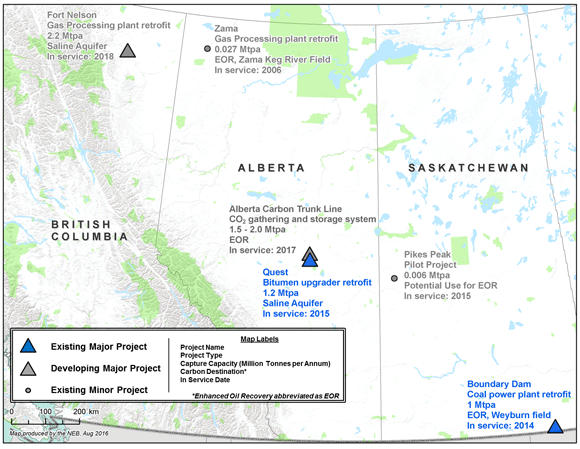Market Snapshot: Canadian carbon capture and storage projects will soon sequester up to 6.4 million tonnes of CO2 per year
Connect/Contact Us
Please send comments, questions, or suggestions for Market Snapshot topics to snapshots@cer-rec.gc.ca
Release date: 2016-09-07
Carbon capture and storage (CCS) projects could play a significant role in helping Canada meet its greenhouse gas (GHG) emissions reduction targets. Under the United Nations Framework Convention on Climate Change (UNFCCC), Canada agreed to reduce emissions to 30% below 2005 levels by 2030, or approximately 200 million tonnes per annum (Mtpa) of carbon dioxide (CO2) equivalent below current levels. The combined capacity of the four major CCS projects in Canada (two operational and two in development) will be up to 6.4 Mtpa, representing 3% of the reduction needed to meet the 2030 target.
Canadian Carbon Capture and Storage Projects
Figure Source and Description
Sources: Massachusetts Institute of Technology, Environment and Climate Change Canada
Description:This map of British Columbia, Alberta, and Saskatchewan illustrates the location of six CCS projects. There are two major existing facilities: Boundary Dam in Estevan Saskatchewan, and Quest near Fort Saskatchewan, Alberta. There are two minor existing facilities located in Zama City, Alberta, and Pikes Peak, Saskatchewan. Lastly, there are two major developing projects: the Alberta Carbon Trunk Line near Redwater, Alberta (potentially in-service by 2017), and a gas plant retrofit in Fort Nelson, British Columbia (potentially in-service by 2018).
The two major operating CCS projects are SaskPower’s Boundary Dam in Estevan, Saskatchewan, and Shell’s Quest project near Fort Saskatchewan, Alberta. Quest captures 1.2 Mtpa of CO2 from oil sands upgrading processes, which is then stored in a deep saline aquifer. Carbon stored in aquifers is permanently sequestered and does not have secondary uses.
Boundary Dam is a coal-fired power plant retrofit that is currently capturing 1 Mtpa of CO2. The captured carbon is sold to Cenovus for use in enhanced oil recovery (EOR) at the Weyburn oil field. This project, which began capturing carbon in October 2014, is the first and only large-scale power plant CCS project in the world, and the first commercial application of post-combustionFootnote 1 carbon capture.
Two large Canadian projects are currently under construction: Spectra’s Fort Nelson and the Alberta Carbon Trunk Line. The Fort Nelson project in British Columbia is a gas processing plant retrofit that will capture 2.2 Mtpa starting in 2018. Carbon from this project would be stored in aquifers.
The Alberta Carbon Trunk Line is a gathering system that will pipe and store CO2 from the Sturgeon Refinery and Agrium Fertilizer Plant near Redwater, Alberta. It will begin service in 2017 with a capacity of 1.5 to 2.0 Mtpa, and the carbon will be used for EOR in the Clive oil reservoir. The project has the potential to connect to other industrial emitters in the region and could eventually transport up to 14.6 Mtpa for EOR or storage in aquifers, potentially making it the largest CCS project in the world.
- Date modified:

